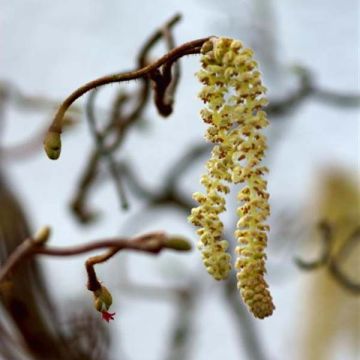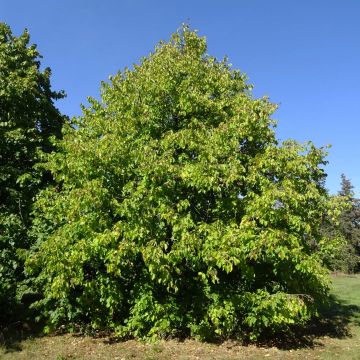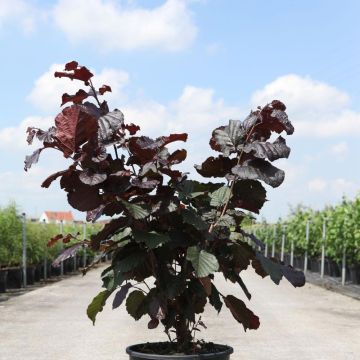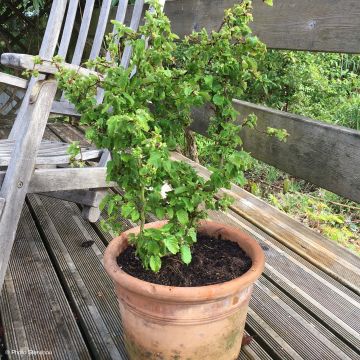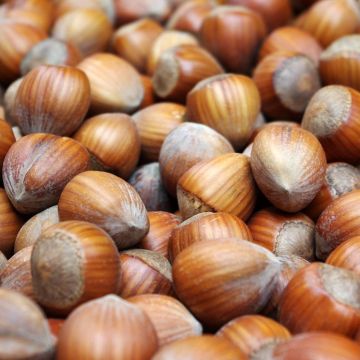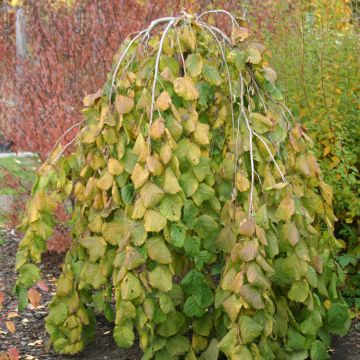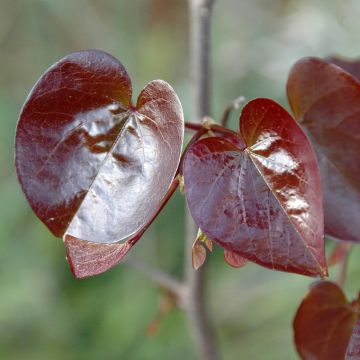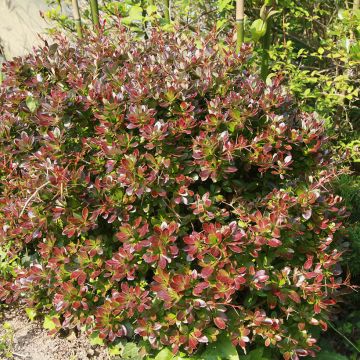

Corylus maxima Juningia - Red Filbert
Corylus maxima Juningia - Red Filbert
Corylus maxima Juningia
Red Filbert, Cobnut
Corylus maxima Juningia looks very beautiful and healthy! The young plant arrived on time and in very good condition! The pruning is slightly larger than indicated!
Valdemar, 10/11/2022
This item cannot be shipped to the selected country
Delivery charge from €5.90
More information
Schedule delivery date,
and select date in basket
This plant carries a 24 months recovery warranty
More information
We guarantee the quality of our plants for a full growing cycle, and will replace at our expense any plant that fails to recover under normal climatic and planting conditions.
From €5.90 for pickup delivery and €6.90 for home delivery
Express home delivery from €8.90.

Does this plant fit my garden?
Set up your Plantfit profile →
Description
Corylus maxima 'Juningia' is a variety of Hazelnut much less known than 'Purpurea', the purple hazelnut bush widely planted in our gardens. This one is decorative with its red flowers in winter and its red summer foliage. 'Juningia' is also highly appreciated for the aromatic flavour of its large nuts protected by a red-tinted shell. This bush is interesting in the background of a border or to form rustic hedges, planted with other hazelnut bushes that will allow it to bear fruit. Vigorous and hardy in all climates, it grows in any soil, preferably rich and moist, in full sun or partial shade. Its delicious nuts are harvested in late summer.
Corylus maxima (synonym Corylus lambertiana) belongs to the Betulaceae family, just like the birch tree. It originates from southeastern Europe and the Caucasus. It is a medium-sized fruit tree, monoecious, bearing distinct male and female inflorescences on the same plant. Lambert's Hazelnut is a species for light and rather chalky soil, fairly fertile and not too dry. Overly hot and dry locations should be avoided.
'Juningia' is a rather rare horticultural selection in cultivation. It differs from Lambert's Hazelnut with its red summer foliage, its red catkins and its large nuts nestled in red bracts. The bush will reach approximately 5 m (16 ft 5 in) in height and 3 m (9 ft 10 in) in width. Its young, hairy shoots are adorned with a light brown bark that will become very dark over time. The flowering occurs in two stages: in February, the male flowers appear, gathered in catkins measuring 6 cm (2.4 in) long, visited by bees. Then, the inconspicuous female flowers bloom in March. They have the shape of a 6 to 8 mm (0.2 to 0.3 in) bud partially concealing bright red stigmas. The dense, deciduous foliage appears late in May and gives the shrub its bushy aspect. The leaves are ovate, strongly veined, and measure 5 to 12 cm (2 to 4.7 in) long. Initially green, they turn red in summer. The fruits that form on 1-year-old shoots are called hazelnuts. They are large and oblong, surrounded by very long red bracts. Clustered in 1 to 4, they ripen from August to September. This hazelnut bush is not self-fertile: it is necessary to plant one or more other hazelnut bushes nearby to obtain abundant fruiting. Also, make sure to remove the numerous suckers that will quickly colonize the space!
The Juningia Hazelnut is an ornamental and delicious fruit tree that grows easily in ordinary soil. It only dislikes excessively dry situations. It is commonly used in the background of a border, in a grove, or as an informal hedge. To accompany it, choose other original and easy-to-grow fruit trees like pawpaws, cherry plums, medlars, pecan nuts...
Report an error about the product description
Plant habit
Flowering
Foliage
Safety measures
Botanical data
Corylus
maxima
Juningia
Betulaceae
Red Filbert, Cobnut
Cultivar or hybrid
atteinterespiratoire
Cette plante peut entraîner des symptômes allergiques.
Evitez de la planter si vous ou vos proches souffrez de rhinite saisonnière ("rhume des foins").
Davantage d'informations sur https://plantes-risque.info
Other Corylus - Hazelnuts
Planting and care
Easy to grow and perfectly hardy, the Corylus maxima 'Juningia' is well suited to most climates. It will adapt to any good, loose garden soil, fairly rich, not too dry, without excessive acidity and preferably limestone. It appreciates a sunny to semi-shaded position and will benefit from regular pruning. In late autumn, thin out the base by cutting back any obstructive branches. During the first 2-3 years, prune to encourage a bushy habit. Afterwards, prune every 3 years to control its growth, in April. Remove any suckers.
Planting period
Intended location
Care
-
, onOrder confirmed
Reply from on Promesse de fleurs
Spring-flowering shrubs
Haven't found what you were looking for?
Hardiness is the lowest winter temperature a plant can endure without suffering serious damage or even dying. However, hardiness is affected by location (a sheltered area, such as a patio), protection (winter cover) and soil type (hardiness is improved by well-drained soil).

Photo Sharing Terms & Conditions
In order to encourage gardeners to interact and share their experiences, Promesse de fleurs offers various media enabling content to be uploaded onto its Site - in particular via the ‘Photo sharing’ module.
The User agrees to refrain from:
- Posting any content that is illegal, prejudicial, insulting, racist, inciteful to hatred, revisionist, contrary to public decency, that infringes on privacy or on the privacy rights of third parties, in particular the publicity rights of persons and goods, intellectual property rights, or the right to privacy.
- Submitting content on behalf of a third party;
- Impersonate the identity of a third party and/or publish any personal information about a third party;
In general, the User undertakes to refrain from any unethical behaviour.
All Content (in particular text, comments, files, images, photos, videos, creative works, etc.), which may be subject to property or intellectual property rights, image or other private rights, shall remain the property of the User, subject to the limited rights granted by the terms of the licence granted by Promesse de fleurs as stated below. Users are at liberty to publish or not to publish such Content on the Site, notably via the ‘Photo Sharing’ facility, and accept that this Content shall be made public and freely accessible, notably on the Internet.
Users further acknowledge, undertake to have ,and guarantee that they hold all necessary rights and permissions to publish such material on the Site, in particular with regard to the legislation in force pertaining to any privacy, property, intellectual property, image, or contractual rights, or rights of any other nature. By publishing such Content on the Site, Users acknowledge accepting full liability as publishers of the Content within the meaning of the law, and grant Promesse de fleurs, free of charge, an inclusive, worldwide licence for the said Content for the entire duration of its publication, including all reproduction, representation, up/downloading, displaying, performing, transmission, and storage rights.
Users also grant permission for their name to be linked to the Content and accept that this link may not always be made available.
By engaging in posting material, Users consent to their Content becoming automatically accessible on the Internet, in particular on other sites and/or blogs and/or web pages of the Promesse de fleurs site, including in particular social pages and the Promesse de fleurs catalogue.
Users may secure the removal of entrusted content free of charge by issuing a simple request via our contact form.
The flowering period indicated on our website applies to countries and regions located in USDA zone 8 (France, the United Kingdom, Ireland, the Netherlands, etc.)
It will vary according to where you live:
- In zones 9 to 10 (Italy, Spain, Greece, etc.), flowering will occur about 2 to 4 weeks earlier.
- In zones 6 to 7 (Germany, Poland, Slovenia, and lower mountainous regions), flowering will be delayed by 2 to 3 weeks.
- In zone 5 (Central Europe, Scandinavia), blooming will be delayed by 3 to 5 weeks.
In temperate climates, pruning of spring-flowering shrubs (forsythia, spireas, etc.) should be done just after flowering.
Pruning of summer-flowering shrubs (Indian Lilac, Perovskia, etc.) can be done in winter or spring.
In cold regions as well as with frost-sensitive plants, avoid pruning too early when severe frosts may still occur.
The planting period indicated on our website applies to countries and regions located in USDA zone 8 (France, United Kingdom, Ireland, Netherlands).
It will vary according to where you live:
- In Mediterranean zones (Marseille, Madrid, Milan, etc.), autumn and winter are the best planting periods.
- In continental zones (Strasbourg, Munich, Vienna, etc.), delay planting by 2 to 3 weeks in spring and bring it forward by 2 to 4 weeks in autumn.
- In mountainous regions (the Alps, Pyrenees, Carpathians, etc.), it is best to plant in late spring (May-June) or late summer (August-September).
The harvesting period indicated on our website applies to countries and regions in USDA zone 8 (France, England, Ireland, the Netherlands).
In colder areas (Scandinavia, Poland, Austria...) fruit and vegetable harvests are likely to be delayed by 3-4 weeks.
In warmer areas (Italy, Spain, Greece, etc.), harvesting will probably take place earlier, depending on weather conditions.
The sowing periods indicated on our website apply to countries and regions within USDA Zone 8 (France, UK, Ireland, Netherlands).
In colder areas (Scandinavia, Poland, Austria...), delay any outdoor sowing by 3-4 weeks, or sow under glass.
In warmer climes (Italy, Spain, Greece, etc.), bring outdoor sowing forward by a few weeks.

































